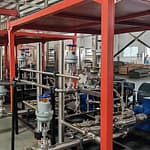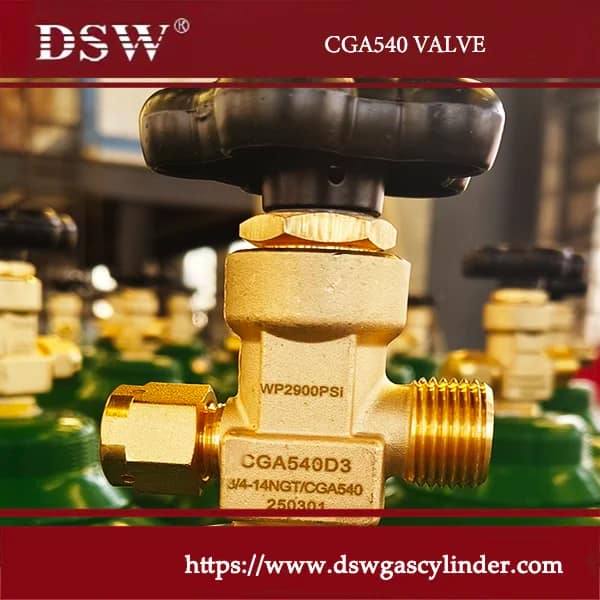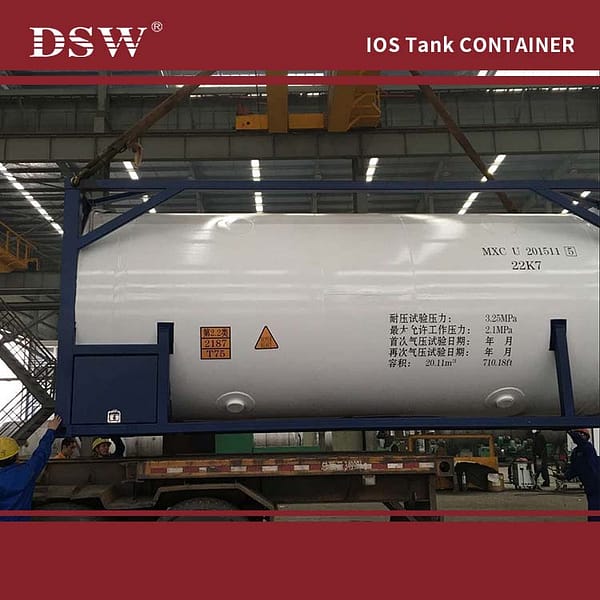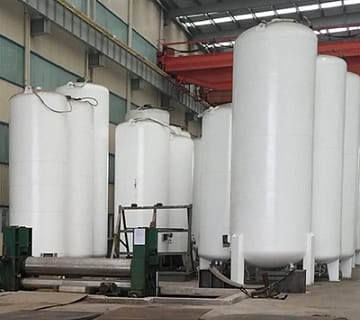Liquid carbon dioxide (CO₂) tanks are precision-engineered pressure vessels designed to safely store CO₂ at low temperature (-20 °C to -35 °C) and high pressure (up to 22 bar / 320 psig). At our factory, we manufacture these liquid co2 tanks by applying advanced engineering principles, certified materials, and strict quality control. Below is a step-by-step look at our technical process.
Step-by-Step Process for Manufacturing a Liquid CO2 Tank
1. Material Selection
Because liquid CO₂ is corrosive in the presence of moisture and requires strength under pressure, we use:
- SA-516 Gr. 70 carbon steel – excellent toughness at low temperature (inner vessels).
- SA-240 stainless steel – optional for enhanced corrosion resistance.
- SA-285 / SA-537 steel – outer jackets, insulation shells.
All materials comply with ASME Section II requirements.
2. Engineering Design
The design follows ASME Section VIII, Division 1 or PED/EN 13445 standards.
The wall thickness of the cylindrical shell is calculated as:
t = (P × R) / (S × E − 0.6P)Where:
- t = minimum wall thickness (mm)
- P = design pressure (MPa)
- R = inner radius of shell (mm)
- S = allowable stress of material (MPa)
- E = weld efficiency (typically 0.85–1.0)
Example: For a 20 bar design pressure and 1500 mm radius using SA-516 Gr. 70 steel with S = 138 MPa and E = 0.9, the required thickness ≈ 32 mm.
Design Pressure & Temperature:
Design pressure: 22 bar (normal working) / 24–26 bar (test)
Design temperature: –40 °C to +50 °C
Capacity Range: From 5 m³ to 100 m³, depending on industrial use.
| Product Parameter | Details |
|---|---|
| Name | 10m³ 16bar Cryogenic LCO₂ Gas Storage Tank |
| Price | [Insert Price] |
| Loading Medium | LCO₂ |
| Effective Volume | 10.0 m³ |
| Working Pressure | 1.6 MPa |
| Overall Dimension | Ø2000 × 7895 mm |
| Design Temperature | -196 ℃ ~ 60 ℃ |
| Outer Cylinder Material | Q345-R |
| Inner Cylinder Material | S30408 |
| Insulation | Vacuum Powder Insulation |
3. Cutting and Forming
Plates are cut using CNC plasma cutting for precision. Rolling machines bend the plates into cylindrical shells. Dished ends are hot-pressed according to DIN 28011 or ASME F&D head geometry.
4. Welding and Assembly
Processes used: Submerged Arc Welding (SAW) for long seams, Gas Tungsten Arc Welding (GTAW/TIG) for nozzles and fittings.
NDT: Radiographic Testing (RT), Ultrasonic Testing (UT), Dye Penetrant Testing (PT).
5. Insulation and Outer Shell
CO₂ tanks require excellent insulation to reduce heat ingress. We use:
- Double-wall construction with vacuum insulation (<5×10⁻³ mbar).
- Expanded perlite + multi-layer aluminized mylar (MLI).
Typical static evaporation rate (NER): 0.2–0.3% per day of capacity.
6. Surface Treatment
- Inner vessel: sandblasted and cryogenic-compatible coatings.
- Outer shell: epoxy paint (≥250 μm thickness) or polished stainless steel finish.
7. Instrumentation and Safety Devices
- Safety relief valves
- Level gauges
- Pressure gauges
- Fill/withdrawal valves
8. Hydrostatic and Pneumatic Testing
- Hydrostatic test at 1.5 × design pressure.
- Pneumatic leak test using helium or nitrogen.
- Vacuum retention test.
9. Final Inspection and Certification
- Dimensional inspection (±2 mm tolerance)
- Radiography & UT reports
- Hydrostatic test certificates
- ASME “U” stamp or CE mark documentation
10. Packaging and Delivery
Tanks are fitted with lifting lugs, saddles, and skid mounts for secure transportation. Export packaging follows ISO 1161 container handling standards.
Conclusion
The production of a liquid-CO₂ tank is a highly technical process involving precise material selection, adherence to pressure vessel design codes, advanced insulation technology, and rigorous testing. At our factory, each tank is engineered for safety, efficiency, and long service life, providing customers with a reliable solution for CO₂ storage and supply.










No comment